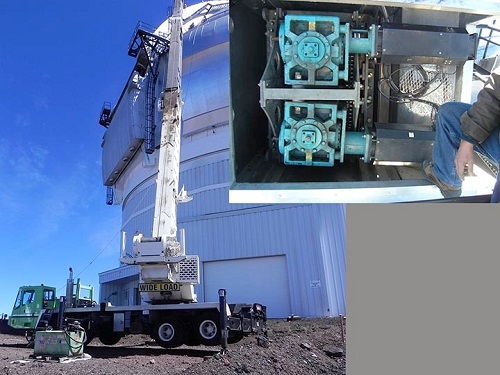2014A Phase I Tool update available
Gemini North Unavailable Until January 24, 2014

The Gemini North enclosure (left) shown with the crane used for the recent installation of the service platform. This platform will be necessary to make repairs to the failed shutter bearing. Inset shows a closeup of the shutter bearing assembly with the skewed assembly (aqua, at bottom).
Announcement of Opportunity for Large and Long Programs
Gemini Observatory announces an opportunity for Large and Long Programs. Eligible PIs are invited to propose scientific investigations to begin observation in the 2014B semester. Letters of Intent are due February 3 2014, and completed proposals are due March 31 2014. Details and requirements are available in the Announcement of Opportunity.
New version of the Gemini IRAF package released (v1.12)
2013B Observing Tool update available
2014A Call for Proposals Announced
Gemini is now accepting proposals for observing time in Semester 2014A. The submission deadline varies with partner and ranges from THURSDAY SEPTEMBER 26 TO WEDNESDAY OCTOBER 2 2013. A new version of the Phase I Tool (PIT) has been released to support proposal submissions.
Update on the Gemini High-resolution Optical Spectrograph (GHOS)
Gemini Planet Imager (GPI): Cleared for Shipment to Gemini South!
In a milestone statement distributed moments ago by the GPI Pre-delivery Acceptance Review Committee, Chair Stephen Goodsell announced that GPI is now clear for shipment from the University of California Santa Cruz to Gemini South in Chile.The Committee’s final report is slated for release on July 26th, but a statement sumarizing the results of the review is available now - GPI Review Committee: Final Day Statement 41 KB
2013B Programs and Schedule Announced
The Gemini 2013B observing programs have now been announced. Successful PIs will receive email notification on June 17 2013. Please check the schedules page for more information. Note that the new Observing Tool must be used to access and update 13B programs.